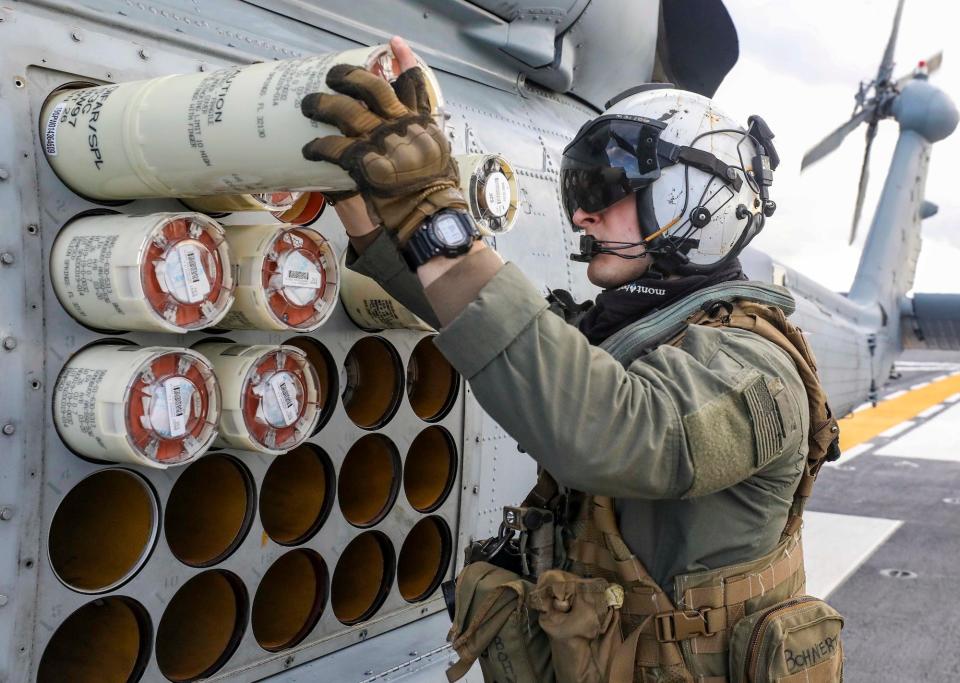China is developing systems to hunt US submarines from the air
China is developing sensors to hunt enemy submarines from aircraft.
Recent patents show a focus on magnetic detection and improved sonobuoys.
New capabilities are critical for China to guard its aircraft carriers, two experts said.
China is developing new systems to hunt the US nuclear-powered submarines that could threaten a Chinese invasion of Taiwan, according to a new report.
The Chinese navy views anti-submarine warfare, or ASW, as essential to any successful amphibious operation and intends to use its aircraft to protect a flotilla from submarine attack by the US or Japan.
"The PLAN [People's Liberation Army Navy] clearly views fixed-wing and vertical lift ASW capabilities as a crucial component necessary for any of its amphibious based contingencies, be that a seizure of an island or reef, or the successful implementation of a Joint Island Landing Campaign against Taiwan," wrote Eli Tirk and Daniel Salisbury in a study for the China Maritime Studies Institute at the Naval War College. "ASW capabilities would be crucial for safeguarding high value surface assets such as carriers or an amphibious landing group, protecting them as they are in port embarking forces, sanitizing the operational area of enemy submarines, and escorting these assets on their way to staging areas and operational areas."
Also significant is that Chinese airborne sub hunters are tasked with protecting Chinese ballistic missile submarines as they sail to their patrol and launch locations. "The PLAN clearly views fixed-wing ASW as an important enabler of its at-sea nuclear deterrent," the report said.
The Chinese navy's current fixed-wing anti-submarine aircraft is the KQ-200, a four-engine turboprop aircraft that is China's equivalent of the US Navy's P-8 Poseidon. The PLAN has about 20 KQ-200s, which have a range of about 3,000 miles.
Much like the US Navy, China's submarine force tends to be secretive. But by examining open-source literature, Tirk and Salisbury were able to discern the efforts China is making in anti-submarine warfare, including patents filed by Chinese researchers.
For example, the state-owned China Electronics Technology Group Corporation filed a patent in 2020 for improved magnetic anomaly detection (MAD), a technology first used in World War II to detect subs by the effect of these big metal objects on the Earth's magnetic field. It's a useful but limited system that usually requires the aircraft to be flying within less than a mile of the target, and can only detect the presence of a sub rather than its course — which means a positive hit must be followed by laying a web of other sensors to be able to target the lurking submarine.
Chinese scientists want to use highly sensitive atomic magnetometers, which use lasers to detect changes in the energy levels between atoms caused by fluctuations in a magnetic field. CETC's patent is for technology that would "enable an atomic magnetometer to sense the direction of a target rather than just its existence," Tirk and Salisbury noted. "According to the filing, previous research on highly-sensitive atomic magnetometers had focused on scalar results (i.e. only the magnitude of a target's magnetic field), but could not provide vectors (i.e. magnitude and direction). MAD is already a shorter-range capability usually used for more precise positioning after other sensors have provided a rough search area, but any additional information could potentially give operators an edge during search operations."

A 2022 patent by Aviation Industry Corporation of China calls for a new system to operate sonobuoys, which are floating canisters, dropped by planes and ships, that detect subs by emitting active sonar signals or by passive sensors that detect the noise of a submarine. Current Chinese sonobuoys require "a complicated and labor-intensive series of manual button presses to configure sonobuoy parameters such as radio working frequency, working depth, working time, and pulse form to fit maritime conditions before deployment."
These parameters aren't displayed on the sonobuoy control system. "This means the display and control system is unaware of whether a sonobuoy is on the rack or has been launched, what type of sonobuoys have been launched, or the parameters of any launched sonobuoys," Tirk and Salisbury wrote. "Instead, operators must manually input this data into the display and control system."
Other patents are for lighter sonobuoys, and improved communications between sonobuoys and aircraft. In 2022, China surpassed America in number of patents filed.
China has also been improving the quality of anti-submarine training. "The PLAN has acknowledged its limitations and has begun taking steps to improve the quality of its ASW training, both in simulators and in physical training environments," the report said. "PLAN ASW units are training under more realistic conditions, and breaking down administrative barriers which prevented them from generating more training opportunities in different operational environments."
For example, since 2015, training materials have stressed the need for ASW aircraft and ships to work closely together, which is standard practice in the US and Western navies. The PLAN is also using simulators to train sensor and weapon operators.
One exercise involved a patrol aircraft transmitting target data to a command ship, "which then integrated it with information from other sources and checked the information against a target information database to confirm whether or not the target was an enemy submarine," the CMSI report noted. "This indicated both a potential command relationship from command vessels to ASW aircraft and confirmed that the PLAN trains to compare potential targets to a database, despite its small (but expanding) ocean surveillance and intelligence collection fleet and a nascent underwater surveillance capability."
Michael Peck is a defense writer whose work has appeared in Forbes, Defense News, Foreign Policy magazine, and other publications. He holds an MA in political science from Rutgers Univ. Follow him on Twitter and LinkedIn.
Read the original article on Business Insider


